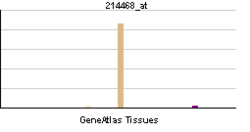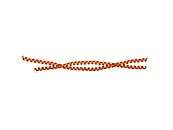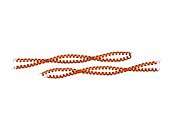MYH6
| View/Edit Human | View/Edit Mouse |
Myosin heavy chain, α isoform (MHC-α) is a protein that in humans is encoded by the MYH6 gene.[3][4] This isoform is distinct from the ventricular/slow myosin heavy chain isoform, MYH7, referred to as MHC-β. MHC-α isoform is expressed predominantly in human cardiac atria, exhibiting only minor expression in human cardiac ventricles. It is the major protein comprising the cardiac muscle thick filament, and functions in cardiac muscle contraction. Mutations in MYH6 have been associated with late-onset hypertrophic cardiomyopathy, atrial septal defects and sick sinus syndrome.
Structure
MHC-α is a 224 kDa protein composed of 1939 amino acids.[5][6] The MYH6 gene is located on chromosome 14q12, approximately ~4kb downstream of the MYH7 gene encoding the other major cardiac muscle isoform of myosin heavy chain, MHC-β. MHC-α is a hexameric, asymmetric motor forming the bulk of the thick filament in cardiac muscle; it is the predominant isoform expressed in human cardiac atria,[7] and the lesser expressed isoform (7%) expressed in human cardiac ventricles.[8] MHC-α is composed of N-termimal globular heads (20 nm) that project laterally, and alpha helical tails (130 nm) that dimerize and multimerize into a coiled-coil motif to form the light meromyosin (LMM), thick filament rod. The 9 nm alpha-helical neck region of each MHC-α head non-covalently binds two light chains, atrial essential light chain (MYL4) and atrial regulatory light chain (MYL7).[9] Approximately 300 myosin molecules constitute one thick filament.[10]
Function
MHC-α isoform is abundantly expressed in both cardiac atria and cardiac ventricles during embryonic development. Following birth, cardiac ventricles predominantly express the MHC-β isoform and cardiac atria predominantly express the MHC-α isoform.[7]
The two isoforms of cardiac MHC, α and β, display 93% homology. MHC-α and MHC-β display significantly different enzymatic properties, with α having 150-300% the contractile velocity and 60-70% actin attachment time as that of β.[9][11]
It is the enzymatic activity of the ATPase in the myosin head that cyclically hydrolyzes ATP, fueling the myosin power stroke. This process converts chemical to mechanical energy, and propels shortening of the sarcomeres in order to generate intraventricular pressure and power. An accepted mechanism for this process is that ADP-bound myosin attaches to actin while thrusting tropomyosin inwards,[12] then the S1-S2 myosin lever arm rotates ~70° about the converter domain and drives actin filaments towards the M-line.[13]
Clinical significance
The first mutation identified in MYH6 by Niimura et al. was found in a patient population with late-onset hypertrophic cardiomyopathy. An Arg to Gln variant was found at position 795 (Arg795Gln). This mutation was located in a region of MHC-α shown to be important for binding essential light chain.[14] Subsequent studies have also found additional mutations in MYH6 linked to both hypertrophic cardiomyopathy and dilated cardiomyopathy.[15]
Mutations in MYH6 cause atrial septal defect.[16] One underlying mutation is a missense substitution at Ile820Asn, which alters the association of alpha-myosin heavy chain with regulatory light chain. MYH6 has been shown to be the predominant sarcomeric disease gene for secundum-type atrial septal defects.[17] Additional studies unveiled an association between MYH6 mutations and a wide array of cardiac malformations in addition to atrial septal defect, including one non-sense mutation, one splicing site mutation and seven non-synonymous coding mutations.[18]
MYH6 has also been identified as a susceptibility gene for sick sinus syndrome. A missense mutation at Arg721Trp was identified as conferring a lifetime risk of 50% for carriers.[19] An in-frame 3-bp deletion mutation in MYH6, in which one residue in MHC-α is removed, enhances the binding of MHC-α to myosin binding protein-C and disrupts normal sarcomere function and cardiac atrial conduction velocity.[20]
Cardiomyopathy from mutation R403Q
Hypertrophic cardiomyopathy (HCM) is a cardiac disease that has some characteristic abnormalities including hypertrophy of the septal wall, disorganized cardiac myocytes, and increase fibrosis within the myocardium. The majority of familial HCM cases have been linked to a mutation in beta-myosin heavy chains converting a single amino acid from an arginine to a glutamine at the 403rd position.[21] More than half of affected people die by the age of 40 because of HCM due to R403Q.[21] The R403Q mutation interferes with the beta-myosin heavy chain and therefore greatly hinders the functionality of the heart muscle.[22] Specifically, the affected muscle cells have slower contractile velocities, have depressed actin-activated ATPase rates, and have increased stiffness.[22]
Due to the fact that the cause of the R403Q mutation lies within the region that encodes for the globular myosin head, alterations in the myosin head structure greatly impairs its ability to strongly interact with actin and form a stable cross-bridge.[22] The development of HCM is multifaceted, but the R403Q mutation is one of the most influential risk factors. Of the hundreds of pathogenic mutations that give rise to HCM, R403Q mutations in myosin heavy chain genes are present in over half of them.[21][22] Since HCM is such a debilitating disease, investigation into possible therapeutic approaches to treat some of the causes of HCM- or at the very least provide palliative care for people affected by this condition- is of extreme importance.
Myh6 knockdown as a therapy for HCM
HCM is an autosomal dominant disease and conventional treatments are ineffective.[23] Gene therapy is currently being investigated as a possible treatment option. Myh6 gene is a possible target for gene therapy.[23] Infected with adeno-associated vectors carrying the siRNA to silence the mutant Mhy6 gene, inhibited expression of R403Q myosin postponed development of HCM for 6 months. Without the dysfunctional myosin protein the heart functioned more efficiently and this prevents the development of myocyte hypertrophy as a compensatory mechanism. Not only was there an absence of HCM, but fibrosis and myocyte disorganization was greatly reduced in the knockdown mice.[23] The proposed mechanism for this is the expression of a more normalized ratio of α-myosin chain to β-myosin chain proteins.[22] This enables proper assembly of myofibrils and thus, more organized sarcomeres.[22] It should be noted, however, that all of the mice in the study developed HCM after 11 months and that the gene therapy was only temporarily therapeutic.
References
- ↑ "Human PubMed Reference:".
- ↑ "Mouse PubMed Reference:".
- ↑ Tanigawa G, Jarcho JA, Kass S, Solomon SD, Vosberg HP, Seidman JG, Seidman CE (Sep 1990). "A molecular basis for familial hypertrophic cardiomyopathy: an alpha/beta cardiac myosin heavy chain hybrid gene". Cell. 62 (5): 991–8. doi:10.1016/0092-8674(90)90273-H. PMID 2144212.
- ↑ "Entrez Gene: MYH6 myosin, heavy chain 6, cardiac muscle, alpha (cardiomyopathy, hypertrophic 1)".
- ↑ "Protein sequence of human MYH6 (Uniprot ID: P13533)". Cardiac Organellar Protein Atlas Knowledgebase (COPaKB). Retrieved 10 August 2015.
- ↑ Zong NC, Li H, Li H, Lam MP, Jimenez RC, Kim CS, Deng N, Kim AK, Choi JH, Zelaya I, Liem D, Meyer D, Odeberg J, Fang C, Lu HJ, Xu T, Weiss J, Duan H, Uhlen M, Yates JR, Apweiler R, Ge J, Hermjakob H, Ping P (Oct 2013). "Integration of cardiac proteome biology and medicine by a specialized knowledgebase". Circulation Research. 113 (9): 1043–53. doi:10.1161/CIRCRESAHA.113.301151. PMC 4076475
 . PMID 23965338.
. PMID 23965338. - 1 2 Schiaffino S, Reggiani C (Apr 1996). "Molecular diversity of myofibrillar proteins: gene regulation and functional significance". Physiological Reviews. 76 (2): 371–423. PMID 8618961.
- ↑ Miyata S, Minobe W, Bristow MR, Leinwand LA (Mar 2000). "Myosin heavy chain isoform expression in the failing and nonfailing human heart". Circulation Research. 86 (4): 386–90. doi:10.1161/01.res.86.4.386. PMID 10700442.
- 1 2 Palmer BM (Sep 2005). "Thick filament proteins and performance in human heart failure". Heart Failure Reviews. 10 (3): 187–97. doi:10.1007/s10741-005-5249-1. PMID 16416042.
- ↑ Harris SP, Lyons RG, Bezold KL (Mar 2011). "In the thick of it: HCM-causing mutations in myosin binding proteins of the thick filament". Circulation Research. 108 (6): 751–64. doi:10.1161/CIRCRESAHA.110.231670. PMC 3076008
 . PMID 21415409.
. PMID 21415409. - ↑ Alpert NR, Brosseau C, Federico A, Krenz M, Robbins J, Warshaw DM (Oct 2002). "Molecular mechanics of mouse cardiac myosin isoforms". American Journal of Physiology. Heart and Circulatory Physiology. 283 (4): H1446–54. doi:10.1152/ajpheart.00274.2002. PMID 12234796.
- ↑ McKillop DF, Geeves MA (Aug 1993). "Regulation of the interaction between actin and myosin subfragment 1: evidence for three states of the thin filament". Biophysical Journal. 65 (2): 693–701. doi:10.1016/S0006-3495(93)81110-X. PMC 1225772
 . PMID 8218897.
. PMID 8218897. - ↑ Tyska MJ, Warshaw DM (Jan 2002). "The myosin power stroke". Cell Motility and the Cytoskeleton. 51 (1): 1–15. doi:10.1002/cm.10014. PMID 11810692.
- ↑ Niimura H, Patton KK, McKenna WJ, Soults J, Maron BJ, Seidman JG, Seidman CE (Jan 2002). "Sarcomere protein gene mutations in hypertrophic cardiomyopathy of the elderly". Circulation. 105 (4): 446–51. doi:10.1161/hc0402.102990. PMID 11815426.
- ↑ Carniel E, Taylor MR, Sinagra G, Di Lenarda A, Ku L, Fain PR, Boucek MM, Cavanaugh J, Miocic S, Slavov D, Graw SL, Feiger J, Zhu XZ, Dao D, Ferguson DA, Bristow MR, Mestroni L (Jul 2005). "Alpha-myosin heavy chain: a sarcomeric gene associated with dilated and hypertrophic phenotypes of cardiomyopathy". Circulation. 112 (1): 54–9. doi:10.1161/CIRCULATIONAHA.104.507699. PMID 15998695.
- ↑ Ching YH, Ghosh TK, Cross SJ, Packham EA, Honeyman L, Loughna S, Robinson TE, Dearlove AM, Ribas G, Bonser AJ, Thomas NR, Scotter AJ, Caves LS, Tyrrell GP, Newbury-Ecob RA, Munnich A, Bonnet D, Brook JD (Apr 2005). "Mutation in myosin heavy chain 6 causes atrial septal defect". Nature Genetics. 37 (4): 423–8. doi:10.1038/ng1526. PMID 15735645.
- ↑ Posch MG, Waldmuller S, Müller M, Scheffold T, Fournier D, Andrade-Navarro MA, De Geeter B, Guillaumont S, Dauphin C, Yousseff D, Schmitt KR, Perrot A, Berger F, Hetzer R, Bouvagnet P, Özcelik C (2011). "Cardiac alpha-myosin (MYH6) is the predominant sarcomeric disease gene for familial atrial septal defects". PLOS ONE. 6 (12): e28872. doi:10.1371/journal.pone.0028872. PMC 3237499
 . PMID 22194935.
. PMID 22194935. - ↑ Granados-Riveron JT, Ghosh TK, Pope M, Bu'Lock F, Thornborough C, Eason J, Kirk EP, Fatkin D, Feneley MP, Harvey RP, Armour JA, David Brook J (Oct 2010). "Alpha-cardiac myosin heavy chain (MYH6) mutations affecting myofibril formation are associated with congenital heart defects". Human Molecular Genetics. 19 (20): 4007–16. doi:10.1093/hmg/ddq315. PMID 20656787.
- ↑ Holm H, Gudbjartsson DF, Sulem P, Masson G, Helgadottir HT, Zanon C, Magnusson OT, Helgason A, Saemundsdottir J, Gylfason A, Stefansdottir H, Gretarsdottir S, Matthiasson SE, Thorgeirsson GM, Jonasdottir A, Sigurdsson A, Stefansson H, Werge T, Rafnar T, Kiemeney LA, Parvez B, Muhammad R, Roden DM, Darbar D, Thorleifsson G, Walters GB, Kong A, Thorsteinsdottir U, Arnar DO, Stefansson K (Apr 2011). "A rare variant in MYH6 is associated with high risk of sick sinus syndrome". Nature Genetics. 43 (4): 316–20. doi:10.1038/ng.781. PMID 21378987.
- ↑ Ishikawa T, Jou CJ, Nogami A, Kowase S, Arrington CB, Barnett SM, Harrell DT, Arimura T, Tsuji Y, Kimura A, Makita N (Apr 2015). "Novel mutation in the α-myosin heavy chain gene is associated with sick sinus syndrome". Circulation. Arrhythmia and Electrophysiology. 8 (2): 400–8. doi:10.1161/CIRCEP.114.002534. PMID 25717017.
- 1 2 3 Tyska MJ, Hayes E, Giewat M, Seidman CE, Seidman JG, Warshaw DM (Apr 2000). "Single-molecule mechanics of R403Q cardiac myosin isolated from the mouse model of familial hypertrophic cardiomyopathy". Circulation Research. 86 (7): 737–44. doi:10.1161/01.res.86.7.737. PMID 10764406.
- 1 2 3 4 5 6 Geisterfer-Lowrance AA, Kass S, Tanigawa G, Vosberg HP, McKenna W, Seidman CE, Seidman JG (Sep 1990). "A molecular basis for familial hypertrophic cardiomyopathy: a beta cardiac myosin heavy chain gene missense mutation". Cell. 62 (5): 999–1006. doi:10.1016/0092-8674(90)90274-i. PMID 1975517.
- 1 2 3 Jiang J, Wakimoto H, Seidman JG, Seidman CE (Oct 2013). "Allele-specific silencing of mutant Myh6 transcripts in mice suppresses hypertrophic cardiomyopathy". Science. 342 (6154): 111–4. doi:10.1126/science.1236921. PMC 4100553
 . PMID 24092743.
. PMID 24092743.
Further reading
- Matsuoka R, Beisel KW, Furutani M, Arai S, Takao A (Dec 1991). "Complete sequence of human cardiac alpha-myosin heavy chain gene and amino acid comparison to other myosins based on structural and functional differences". American Journal of Medical Genetics. 41 (4): 537–47. doi:10.1002/ajmg.1320410435. PMID 1776652.
- Brand NJ, Dabhade N, Yacoub M, Barton PJ (Sep 1991). "Determination of the 5' exon structure of the human cardiac alpha-myosin heavy chain gene". Biochemical and Biophysical Research Communications. 179 (3): 1255–8. doi:10.1016/0006-291X(91)91707-J. PMID 1930170.
- Solomon SD, Geisterfer-Lowrance AA, Vosberg HP, Hiller G, Jarcho JA, Morton CC, McBride WO, Mitchell AL, Bale AE, McKenna WJ (Sep 1990). "A locus for familial hypertrophic cardiomyopathy is closely linked to the cardiac myosin heavy chain genes, CRI-L436, and CRI-L329 on chromosome 14 at q11-q12". American Journal of Human Genetics. 47 (3): 389–94. PMC 1683877
 . PMID 1975475.
. PMID 1975475. - Ehrlich PH, Moustafa ZA, Ostberg L (1991). "Nucleotide sequence of chimpanzee Fc and hinge regions". Molecular Immunology. 28 (4-5): 319–22. doi:10.1016/0161-5890(91)90143-8. PMID 2062315.
- Matsuoka R, Yoshida MC, Kanda N, Kimura M, Ozasa H, Takao A (Feb 1989). "Human cardiac myosin heavy chain gene mapped within chromosome region 14q11.2----q13". American Journal of Medical Genetics. 32 (2): 279–84. doi:10.1002/ajmg.1320320234. PMID 2494889.
- Yamauchi-Takihara K, Sole MJ, Liew J, Ing D, Liew CC (May 1989). "Characterization of human cardiac myosin heavy chain genes". Proceedings of the National Academy of Sciences of the United States of America. 86 (10): 3504–8. doi:10.1073/pnas.86.10.3504. PMC 287166
 . PMID 2726733.
. PMID 2726733. - Kurabayashi M, Tsuchimochi H, Komuro I, Takaku F, Yazaki Y (Aug 1988). "Molecular cloning and characterization of human cardiac alpha- and beta-form myosin heavy chain complementary DNA clones. Regulation of expression during development and pressure overload in human atrium". The Journal of Clinical Investigation. 82 (2): 524–31. doi:10.1172/JCI113627. PMC 303543
 . PMID 2969919.
. PMID 2969919. - Saez LJ, Gianola KM, McNally EM, Feghali R, Eddy R, Shows TB, Leinwand LA (Jul 1987). "Human cardiac myosin heavy chain genes and their linkage in the genome". Nucleic Acids Research. 15 (13): 5443–59. doi:10.1093/nar/15.13.5443. PMC 305971
 . PMID 3037493.
. PMID 3037493. - Epp TA, Dixon IM, Wang HY, Sole MJ, Liew CC (Dec 1993). "Structural organization of the human cardiac alpha-myosin heavy chain gene (MYH6)". Genomics. 18 (3): 505–9. doi:10.1016/S0888-7543(11)80006-6. PMID 8307559.
- Shoeman RL, Sachse C, Höner B, Mothes E, Kaufmann M, Traub P (Jan 1993). "Cleavage of human and mouse cytoskeletal and sarcomeric proteins by human immunodeficiency virus type 1 protease. Actin, desmin, myosin, and tropomyosin". The American Journal of Pathology. 142 (1): 221–30. PMC 1886840
 . PMID 8424456.
. PMID 8424456. - Nakao K, Minobe W, Roden R, Bristow MR, Leinwand LA (Nov 1997). "Myosin heavy chain gene expression in human heart failure". The Journal of Clinical Investigation. 100 (9): 2362–70. doi:10.1172/JCI119776. PMC 508434
 . PMID 9410916.
. PMID 9410916. - Heidkamp MC, Russell B (Jul 2001). "Calcium not strain regulates localization of alpha-myosin heavy chain mRNA in oriented cardiac myocytes". Cell and Tissue Research. 305 (1): 121–7. doi:10.1007/s004410100400. PMID 11512664.
- Niimura H, Patton KK, McKenna WJ, Soults J, Maron BJ, Seidman JG, Seidman CE (Jan 2002). "Sarcomere protein gene mutations in hypertrophic cardiomyopathy of the elderly". Circulation. 105 (4): 446–51. doi:10.1161/hc0402.102990. PMID 11815426.
- Gupta M, Sueblinvong V, Raman J, Jeevanandam V, Gupta MP (Nov 2003). "Single-stranded DNA-binding proteins PURalpha and PURbeta bind to a purine-rich negative regulatory element of the alpha-myosin heavy chain gene and control transcriptional and translational regulation of the gene expression. Implications in the repression of alpha-myosin heavy chain during heart failure". The Journal of Biological Chemistry. 278 (45): 44935–48. doi:10.1074/jbc.M307696200. PMID 12933792.
- Narolska NA, van Loon RB, Boontje NM, Zaremba R, Penas SE, Russell J, Spiegelenberg SR, Huybregts MA, Visser FC, de Jong JW, van der Velden J, Stienen GJ (Jan 2005). "Myocardial contraction is 5-fold more economical in ventricular than in atrial human tissue". Cardiovascular Research. 65 (1): 221–9. doi:10.1016/j.cardiores.2004.09.029. PMID 15621050.
- Ching YH, Ghosh TK, Cross SJ, Packham EA, Honeyman L, Loughna S, Robinson TE, Dearlove AM, Ribas G, Bonser AJ, Thomas NR, Scotter AJ, Caves LS, Tyrrell GP, Newbury-Ecob RA, Munnich A, Bonnet D, Brook JD (Apr 2005). "Mutation in myosin heavy chain 6 causes atrial septal defect". Nature Genetics. 37 (4): 423–8. doi:10.1038/ng1526. PMID 15735645.
- Carniel E, Taylor MR, Sinagra G, Di Lenarda A, Ku L, Fain PR, Boucek MM, Cavanaugh J, Miocic S, Slavov D, Graw SL, Feiger J, Zhu XZ, Dao D, Ferguson DA, Bristow MR, Mestroni L (Jul 2005). "Alpha-myosin heavy chain: a sarcomeric gene associated with dilated and hypertrophic phenotypes of cardiomyopathy". Circulation. 112 (1): 54–9. doi:10.1161/CIRCULATIONAHA.104.507699. PMID 15998695.
- Narolska NA, Eiras S, van Loon RB, Boontje NM, Zaremba R, Spiegelen Berg SR, Stooker W, Huybregts MA, Visser FC, van der Velden J, Stienen GJ (2006). "Myosin heavy chain composition and the economy of contraction in healthy and diseased human myocardium". Journal of Muscle Research and Cell Motility. 26 (1): 39–48. doi:10.1007/s10974-005-9005-x. PMID 16088376.


